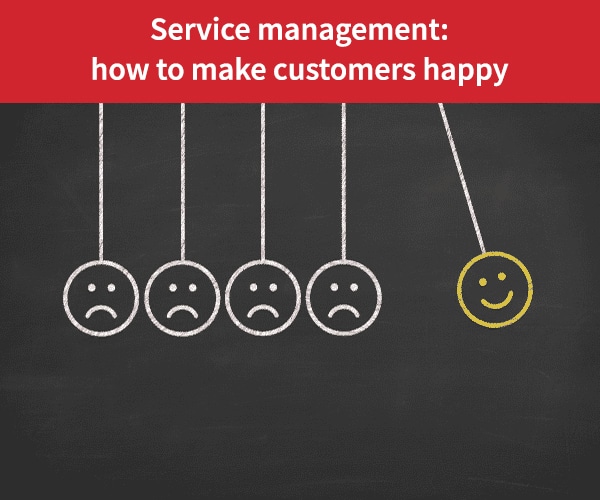
- Customer Satisfaction
- Field Service Management
- Gestion d’interventions
- Optimization
- Satisfaction Client
How service companies can make customers happy
Managing field service operations is a difficult art. Nobody’s perfect and any organization can falter at some point. At the same time, customers are increasingly difficult to satisfy and their demands for high-quality service continue to rise. We’re living in an era where companies such as Amazon, Uber and Airbnb have taken service to new levels of excellence. Customers are used to maximum responsiveness, real-time information and service that’s close to flawless. And they’ve brought these high expectations to the field service industry. To make customers happy, it’s important to put them at the center of your field service management strategy. Training your teams to listen and giving them the right software solutions significantly and quickly improves the quality of service you can deliver to customers and, as a result, their satisfaction levels. Even if you don’t think that’s the case, your competition does because unhappy customers are disloyal customers. Here’s a closer look at steps you can take to make customers happy.
Put customers at the heart of your business strategy
To meet rising demands, quality of service and customer experience must be at the center of every service company’s strategy. From time to time, there may be unhappy customers. But at no time should these situations be tolerated. Every service company must view every customer with respect and do everything possible to meet their contractual commitments. In an increasingly competitive economic environment, customer satisfaction is a key issue for service companies. It can be considered the most important issue because it’s a very important way to differentiate from competitors. And this isn’t just the case today. Even back in 2011, the Right Now Customer Experience Impact Report showed that 89% of customers in the US abandon their relationship with a provider after a single experience with poor service. Another study by the White House Office of Consumer Affairs showed that it is 6 to 7 times more expensive for a business to acquire a new customer than to keep a current one. And a 2012 study by Global Customer Service Barometer said customers are twice as likely to share their bad experience as they are to talk about their positive experiences. All of these statistics confirm the same thing: the customer experience must be at the heart of a company’s strategy. And this is even truer in the field services industry.
Use customer feedback to improve performance
A dissatisfied customer should be viewed as an opportunity to optimize the quality of service offered. Unhappy customers expose pain points. But service companies must focus on their pain points to rise to the highest levels of performance and outperform their competitors. Of course, there are always customers who are perpetually dissatisfied. But the majority of unhappy customers are typical people who have relatively basic concerns about the service provided to them. When you take the time to look at their sticking points and resolve any issues, there’s nothing insurmountable in their concerns. In addition, customers may understand that service companies will mishandle their experience at some point. If service companies can quickly resolve issues and satisfy customers, it can be a good way to retain customers over the long term because they feel their concerns are being considered.
Train teams to listen to customers
In general, when a conversation between two people heats up, neither listens to the other’s arguments. This same pattern often recurs with an unhappy customer. This is why it’s important for managers at service companies to train their teams to listen to dissatisfied customers. Call center staff and field technicians should receive this type of training. There’s always a way to turn an exchange with an unhappy customer into a constructive conversation. Teams must be trained to put the customer at the center of their activities. They must be able to listen and take customer complaints into account.
Listen to the customer to defuse complicated situations
Attentive listening is a great way for service companies to show customers their perspective is truly being heard, and it very often helps to defuse crises. Service companies must let customers verbalize their problems, listen and consider their complaints, then find a mutually satisfactory solution to the issue.
Use technology to manage field service operations
To put customers at the center of their strategies, service companies need a well-oiled organization and a flexible, responsive and efficient way to manage technicians. It’s important to be equipped with the right tool, in particular field service management software such as Praxedo offers, to provide an acceptable level of service. To improve performance, the entire service life cycle, from the customer’s initial request through to completion must be paperless. In the era of the digital economy, using paper is no longer adequate to create technicians’ schedules or write service reports. Going digital is essential to provide customers with a smooth, trouble-free experience.
Choose the right field service management software
With field service management software, service companies can optimize technicians’ travel routes, manage subcontractor activities, geolocate technicians and communicate in real time with customers. When the field service management software is powered by an artificial intelligence engine, such as Praxedo’s SmartScheduler is, service companies gain important, performance-enhancing capabilities. They can create complex schedules in real time while taking into account a large number of parameters, such as the:
-
Type of service to be provided
-
Skills, availability and location of the technicians that could be assigned to the job
-
Optimal travel route based on traffic conditions
Give technicians a mobile app
A mobile app for technicians also provides important benefits. It helps technicians save time while providing service and avoid making errors in service reports. A mobile app also eliminates the administrative time spent re-entering information and, ultimately, reduces the amount of time required to create and send invoices to customers. For example, with a customized connector, the Praxedo field service management software can be integrated with an invoicing solution such as Sage Financials or Intuit Quickbooks. This allows service companies to digitize the entire service process from A to Z and send invoices to customers almost immediately after technicians complete on-site service.
Our similar articles.
-
- Field Service Management
- Optimization
Understanding the role of facilities managers in day-to-day operations and what does a facilities manager do
September 16, 2021 -
- Field Service Management
- Field Service Management
- Productivité
- fiber optic deployments
- fiber optic deployments
- FTTH
- telecommunication
- FTTH
- telecommunication
The next chapter for Fiber to the Home (FTTH)
May 3, 2023 -
- Field Service Management
- Field Service Management
- scheduling
- scheduling
- field technicians
- field technicians
7 things successful service companies do, that you should do too
October 3, 2022


